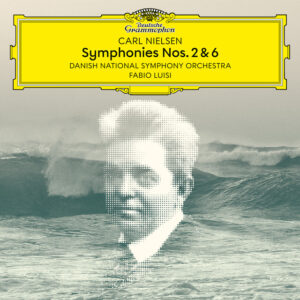GRAMOPHONE Review: Nielsen Symphonies Nos. 2 & 6 – Danish National Symphony Orchestra/Luisi
 The final instalment in this marvellous cycle of the Carl Nielsen symphonies does not disappoint. The Danish National Symphony Orchestra serve their national hero with self-evident pride and big-heartedness and the Italian at the helm – Fabio Luisi – seems instinctively to know how the music goes and how best to capture its essence. Its much talked about ‘progressive tonality’ drives a much deeper purpose.
The final instalment in this marvellous cycle of the Carl Nielsen symphonies does not disappoint. The Danish National Symphony Orchestra serve their national hero with self-evident pride and big-heartedness and the Italian at the helm – Fabio Luisi – seems instinctively to know how the music goes and how best to capture its essence. Its much talked about ‘progressive tonality’ drives a much deeper purpose.
Symphony No 2 ‘The Four Temperaments’ was inspired, we know, by a comic etching and it is the image of ‘The Choleric’ on horseback which has us poised for the propulsive opening. The gorgeous second subject is the flip-side, the romantic fancy, of the image and in its explosive return Luisi avoids bombast by simply letting the tutti sound ‘radiate’. Everything is airborne – and superb engineering strikes the idea balance between the spacious and the immediate. For once ‘The Melancholic’ slow movement – a very expansive Andante – is the rue heart and soul of the piece, quite exceptional in its depth of sound and expression. There is such nobility, too, in the return of the opening theme, writ large in strings and horns, towards the close.
In Nielsen’s last symphony, the Sixth, the simple chiming of a glockenspiel (as in Shostakovich’s last symphony) suggests the nursery door might be swinging open one last time. Childish things have not been put away but the games are now heavy with irony and the benefit of hindsight. The Sixth is cryptic and (like the Shostakovich) baffling at first but there is method in the madness and the invention, the constant springing of surprise, comes from the devil-may-care audacity of the musical gamesmanship. The ‘heart attacks’ so graphically disruptive in the first movement (Nielsen had recently suffered a real one) are enacted here with fabulous precision – and there is even a mad fugue (redolent of Shostakovich’s Fourth) attempting to restore order and a kind of musical normality.
The renegade side drum from the Fifth is still disruptive and argumentative in the (percussion and wind only) second movement ‘Humoreske’ but he and his titillating colleagues (vividly caught here) are in a more genial frame of mind despite an outrageous crew of trombones who when not yawning are rudely blowing raspberries.
Through it all Luisi and his players keep us on message (making a kind of logic of the illogical) and where Nielsen wears his nostalgic heart on his sleeve (all roads in that regard lead to the slow movement) the conviction behind the playing is personal to the point of possessiveness. This orchestra lives its heritage.
I wonder if Nielsen envisaged his symphonic canon signing off with another raspberry – this time from a solo bassoon? At any rate it had to end somehow, right? And I’m going to end by sticking my neck out and saying that this cycle is spiritually and sonically the best we’ve yet had on disc.




